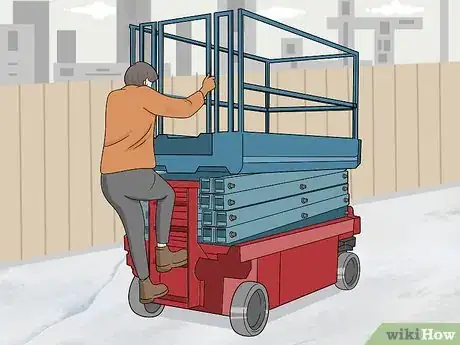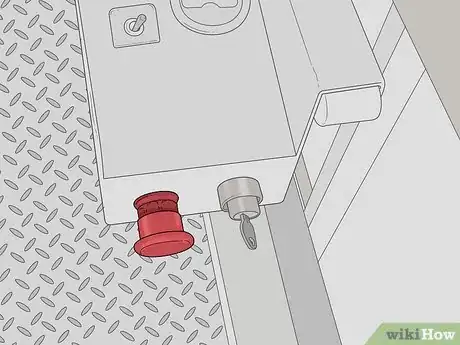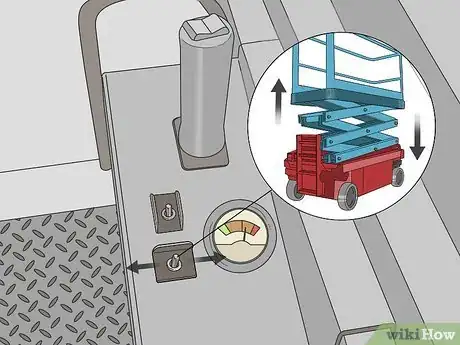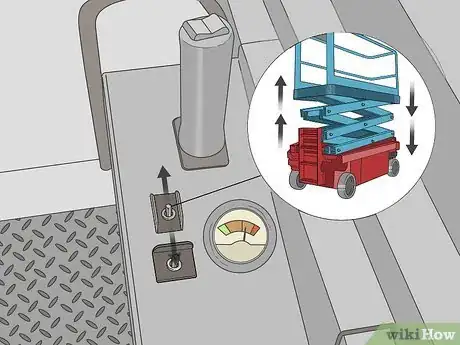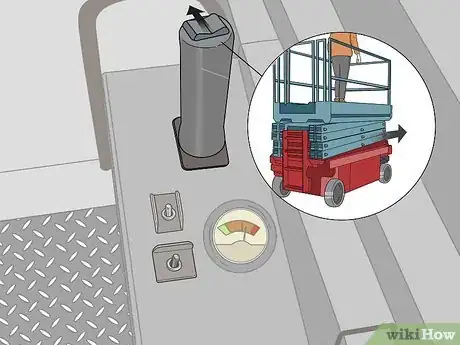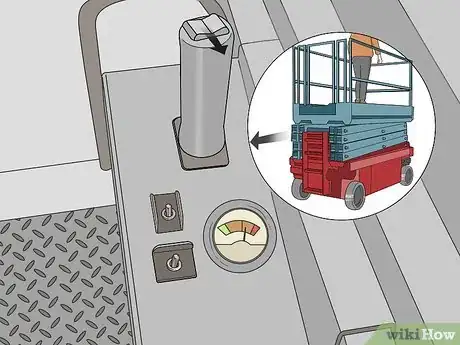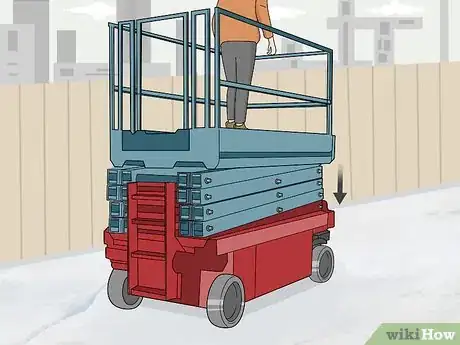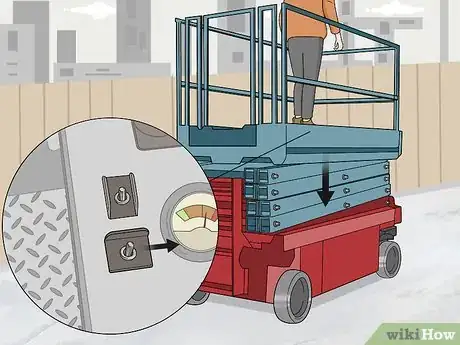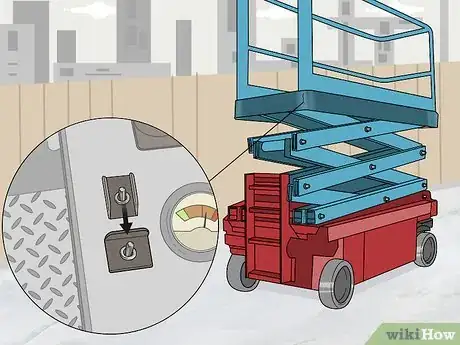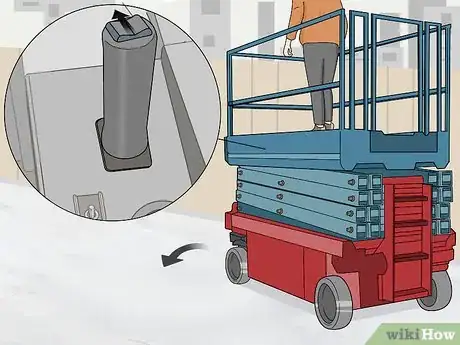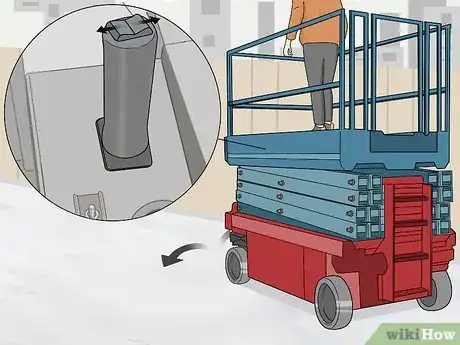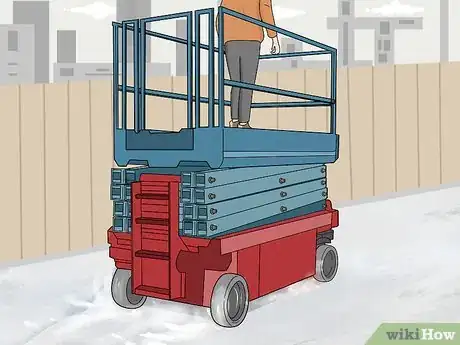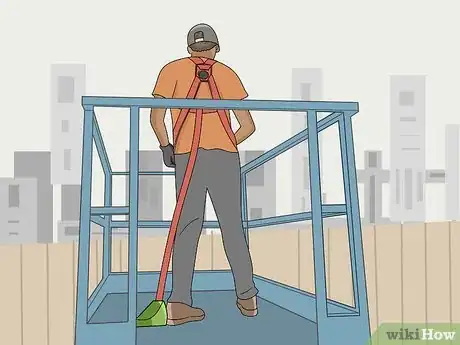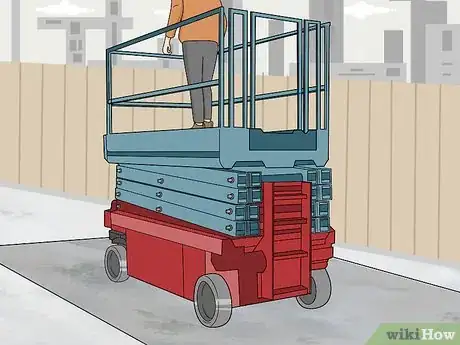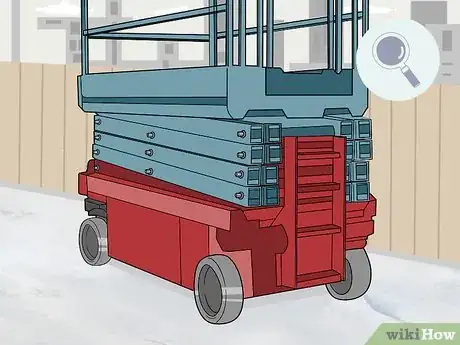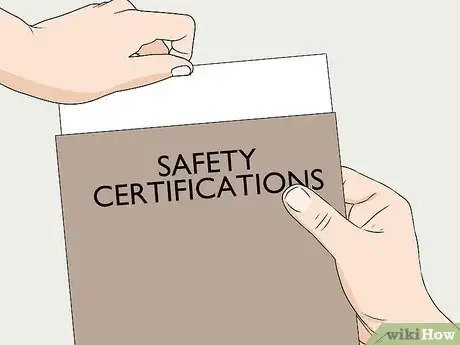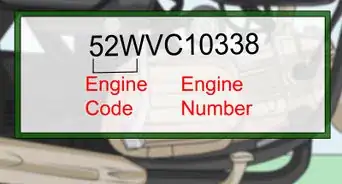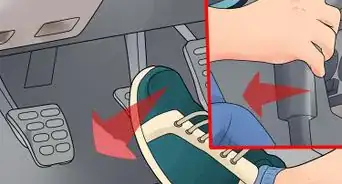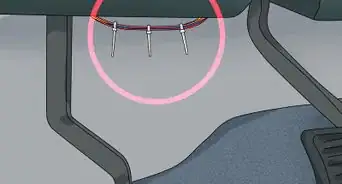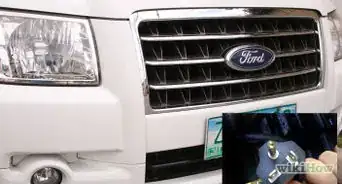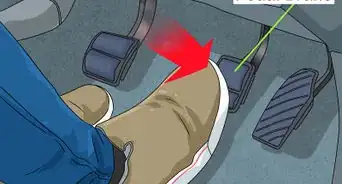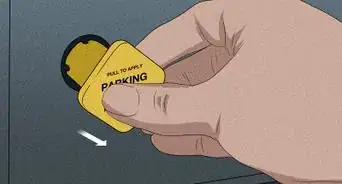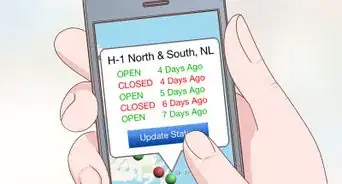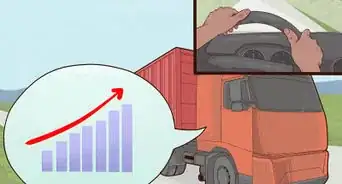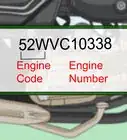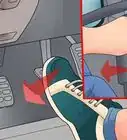This article was co-authored by wikiHow staff writer, Eric McClure. Eric McClure is an editing fellow at wikiHow where he has been editing, researching, and creating content since 2019. A former educator and poet, his work has appeared in Carcinogenic Poetry, Shot Glass Journal, Prairie Margins, and The Rusty Nail. His digital chapbook, The Internet, was also published in TL;DR Magazine. He was the winner of the Paul Carroll award for outstanding achievement in creative writing in 2014, and he was a featured reader at the Poetry Foundation’s Open Door Reading Series in 2015. Eric holds a BA in English from the University of Illinois at Chicago, and an MEd in secondary education from DePaul University.
There are 14 references cited in this article, which can be found at the bottom of the page.
This article has been viewed 41,688 times.
Learn more...
A scissor lift is a drivable machine with a platform that raises and lowers. It is typically used for maintenance and construction, but can also be used in a warehouse to reach shelves. Some film crews will also use scissor lifts to get a unique camera angles. To operate a scissor lift, use the horizontal switch to swap between driving and raising the platform. Use the vertical switch to change the lift’s speed. Use the joystick to control the direction that you drive or move the platform. Always take the proper safety precautions by wearing a safety harness and waiting for the scissor lift to reach a complete stop before entering a new input.
Steps
Turning the Machine On and Off
-
1Climb into the scissor lift through the gate on the side rail. To enter the scissor lift, unhook the chains or open the gate on the side of the platform. Step on the base of the scissor lift and climb under the top rail to enter the machine. Once inside of the scissor lift, either close and lock the gate or reattach the chains back on to their corresponding hooks to secure the lift.[1]
- Some gates use a latch to lock the guard rail in place. If you can’t open the door, look for a locking mechanism where the door meets the frame of the machine and flip it up to unlock it.
- Never operate a scissor lift without securing the gate on the side rail.
-
2Put the key into the ignition to turn the lift on. Scissor lifts use a key to start the lift and turn it off. Take your key and insert it into the ignition next to the large red button on the control panel. Turn the key to the right to turn the lift on. The control panel is the small box with the joystick inside of the lift.[2]
Tip: Most operators and rental companies leave the key in the ignition when the lift is not being used. If you aren’t sure where the key is, check the control panel first.
Advertisement -
3Use the big red button to stop the machine at any time. If you ever need to shut off the power to the lift or lose control of the joystick, press the large red button next to the key. This is the emergency shut off button, and pressing it will immediately cut the power to the battery.[3]
- If you need to restart the machine after using the emergency shut off button, simply pull the button out and use the key to restart the scissor lift.
Moving Up and Down
-
1Flip the horizontal switch to the left to turn the hydraulics on. There are 2 switches on the control panel. Find the horizontal switch that flips to the left and right. Set this switch to the left to turn the hydraulic system on and allow the scissor lift to move up and down. On some scissor lifts, each switch position is labelled. On these lifts, flip the horizontal switch to the “Platform” or “Up/Down” position.[4]
Tip: The horizontal switch can be set in the neutral position by flipping it to the middle. If you flip the switch to the right, you turn on the motor to move the wheels. Always check this switch before moving the joystick.
-
2Use the vertical switch to set the speed of the lift to “slow.” There is rarely a good reason to set the vertical switch to the “fast” setting, which is the up-position. To ensure that the machine raises and lowers slowly and remains under your control, flip the vertical switch to its lowest position. On some lifts, this switch position will be labeled “slow.”[5]
- You’re more likely to have an accident or lose control of the lift if it’s moving quickly.
- The fast setting is usually reserved for warehouse workers that only use a scissor lift to access higher shelves in a specific location where the lift doesn’t need to be driven.
-
3Push the joystick forward to raise the scissor lift. With the switch in the left-most position, push the joystick forward to raise the platform. If you want to stop moving the platform, move the stick to the center to stop raising the platform. Alternatively, you can release the joystick and allow it to pop back to the neutral position.[6]
- The joysticks on scissor lifts will almost always flip back to the center so that the lift stops moving when you release the joystick.
- When going up, stay alert and look above and around you to ensure that you don’t strike anything while moving up.
- Make sure that nobody is standing nearby the lift while you’re raising it.
-
4Pull the joystick back to lower the lift back down. To lower the lift, simply pull the stick back towards you. The platform will continue to lower so long as you keep the joystick held back. To stop moving down, either push the joystick to the center position or release the handle.[7]
- Before you move a lift down, look over the rails to make sure that it’s safe. The rails fold on one another as a scissor lift lowers, and a person may be injured if they’re touching the lift when it starts moving.
- As you move down, look down to keep an eye out for people passing by. Do not lower a scissor lift if someone is within 20 feet (6.1 m) of the lift.
Driving the Scissor Lift
-
1Lower the scissor lift all the way down before driving it. Before you drive anywhere, lower the lift as low as it can go. Your scissor lift will be more likely to tip over if you drive it while the platform is raised. Never drive the lift if the platform is raised.
- Depending on where you live, it is usually a safety violation to move a scissor lift if the platform is raised.
-
2Set the horizontal switch all the way to the right. To shut off the hydraulic power and shift the lift into drive mode, identify the horizontal switch on your control panel. Flip this switch all the way to the right. If the controls are labeled, this position is usually labeled “drive.”[8]
- You cannot raise or lower the platform while the lift is in drive mode, so always lower the platform before using this switch.
-
3Set the vertical switch to the “slow” position to stay safe. When you drive the lift, the speed of the lift is controlled by the vertical switch. Flip this switch all the way to the lowest position to ensure that you maintain control of the lift while you’re driving it.[9]
- The “fast” position is usually used to navigate rows in a warehouse where the lift doesn’t need to go left or right.
-
4Push the joystick forward or backward to drive the lift. With the horizontal switch flipped all the way to the right, push the joystick forward to drive forward. If you want to go in reverse, pull the joystick backwards. Always wait for the lift to come to a complete stop before swapping between forward and reverse.[10]
Tip: Newer scissor lift joysticks are calibrated to be sensitive to how hard you push or pull it when the stick is in drive mode. If you barely move the stick, you will move a few inches at a time. If you push the stick all the way in either direction, you will move as fast as your speed setting allows.
-
5Use the toggle on the top of the joystick to move left or right. If you want to change directions, press the toggle switch on top of the joystick with your thumb. If you want to turn left, press the left side of the switch down. If you want to turn right, press the right side of the switch down. Hold the switch in place to continue rotating the lift as you drive.[11]
- Scissor lifts can’t turn at sharp angles; it usually takes multiple control inputs to turn the lift around sharp corners.
-
6Move slowly and take breaks between movements to stay safe. Scissor lifts can be kind of awkward to drive, especially if you aren’t used to using them. To stay safe while driving a scissor lift, only use one control input at a time and carefully monitor the speed and direction of the lift as it moves. Release the joystick in between inputs to allow the scissor lift to stop moving before changing directions. Never change directions without letting the lift come to a complete stop first.[12]
- While driving the lift, always look at the ground where you’re driving the lift to watch out for obstructions or changes in the texture of the floor. If you’re outside, look up once every 2-3 seconds to make sure that you aren’t at risk of running into a powerline or tree.
- If you move the joystick back and forth while changing directions at the same time, you may knock the scissor lift over or fall off of the platform. In addition, you may run into an obstruction or hole if you move too quickly, which can disrupt the lift or knock you off.
Taking the Proper Safety Precautions
-
1Wear a safety harness and connect it to the strap on the platform. Get a safety harness from a construction supply store or a scissor lift manufacturer. Put the harness on and clip it in the center and on the sides to secure it. Pull the straps on each side to tighten it to your frame. On the floor of the platform, look for a retractable length of nylon with a hook on the end. Clip this hook to your safety harness to stay safe if you fall.[13]
- The nylon strap will extend 6 feet (1.8 m) before locking, so you have plenty of room to move around on the platform.
-
2Monitor the battery or fuel gauge to ensure you don’t get stuck. There is a gauge next to the switches on your control panel that measures how much fuel or electricity is left. Monitor this gauge carefully while operating your lift to ensure that you don’t run out of fuel or electricity while you’re raised up in the air.[14]
- If you do run out of energy while the platform is raised, you’ll need someone else to charge the battery or fill the tank for you before you can get back down. (If this isn't practical there should be a manual pressure relief valve on the scissor lift allowing it to be lowered regardless of battery or fuel status - consult the manual or manufacturer for this.)
- The vast majority of scissor lifts are electric.
-
3Operate the scissor lift on firm, flat surfaces. Never use a scissor lift on grass, gravel, or unstable ground. Scissor lifts tend to become quite unstable if they’re on an uneven surface, which is a serious safety hazard. Only use a scissor lift on asphalt, concrete, or hardwood surfaces.[15]
Tip: It is usually illegal to operate a scissor lift on an uneven surface.
-
4Inspect the scissor lift before using it to check for wear and tear. Before using a scissor lift, always walk around the exterior of the machine. Inspect each wheel to look for punctures or tears. Check each tire to ensure that your wheels are properly inflated. Check the rails that lift the platform for cracks or obstructions to ensure that the machine is safe to operate.[16]
- If you’re unsure if a scissor lift is safe to use, have a certified mechanic inspect the machine before using it.
-
5Get certified as a scissor lift operator if you want to really stay safe. If you’re operating a scissor lift for your employer, they are legally required to train you on how to use the scissor lift. If you’re renting a scissor lift, consider taking a safety class in your area to earn an operator certification. While this certification isn’t normally required to use a scissor lift, it’s a good way to ensure that you don’t make a serious mistake when using the machine.[17]
- Operator certifications for scissor lifts usually take less than a week to earn.
- In some states and countries, you are required to take a class on scissor lifts before you are allowed to operate one. However, these safety certifications are optional everywhere else.
- While it changes depending on where you live, scissor lifts are usually considered to be a type of scaffolding. Standing on scaffolding does not typically require a certification.[18]
Community Q&A
-
QuestionWhat signs should be erected when in use?
 Mzm555Top AnswererAt minimum, a "Warning, Mobile plant operating in area" sign should be the minimum. Ideally, pedestrian exclusion areas or permanent floor markings should be used, but are not always possible. If available, a spotter should be used where there are hazardous obstructions at ground or overhead level - e.g. power lines, manhole grates, etc.
Mzm555Top AnswererAt minimum, a "Warning, Mobile plant operating in area" sign should be the minimum. Ideally, pedestrian exclusion areas or permanent floor markings should be used, but are not always possible. If available, a spotter should be used where there are hazardous obstructions at ground or overhead level - e.g. power lines, manhole grates, etc. -
QuestionCan you move a scissor lift by walking alongside it?
 Mzm555Top AnswererYou usually can by detaching the control console from the scissor lift frame - though this is usually only done when performing high risk maneuvers where standing in the lift would be too dangerous - e.g. when driving the scissor lift on steel ramps to be transported by truck or trailer. When this is done the upmost care must be taken to stand as far away as possible from the scissor lift as the controls will allow. Move the controls slowly, smoothly, and carefully. Utilizing the aid of a spotter is also ideal if possible.
Mzm555Top AnswererYou usually can by detaching the control console from the scissor lift frame - though this is usually only done when performing high risk maneuvers where standing in the lift would be too dangerous - e.g. when driving the scissor lift on steel ramps to be transported by truck or trailer. When this is done the upmost care must be taken to stand as far away as possible from the scissor lift as the controls will allow. Move the controls slowly, smoothly, and carefully. Utilizing the aid of a spotter is also ideal if possible.
Warnings
- Scissor lifts need to be inspected every year by a certified mechanic. If you’re renting a scissor lift, ask for the inspection record before handing any money over to ensure that the machine is functioning correctly.[19]⧼thumbs_response⧽
- Never raise a scissor lift if it’s windy. It doesn't take much force to topple over a scissor lift even when not at maximum height. The wind can easily knock a raised scissor lift over.⧼thumbs_response⧽
- Never overload the platform with heavy materials. The weight restrictions for a scissor lift can be looked up online or found on the safety sticker, which is usually located on the control panel.⧼thumbs_response⧽
- Avoid strong pushing or pulling of things when up high in a scissor lift - as previously mentioned it doesn't take much to tip one over - in can take as little as 25 kg (55 lbs) to tip especially at height.⧼thumbs_response⧽
Things You’ll Need
- Safety harness
References
- ↑ http://az776130.vo.msecnd.net/media/docs/default-source/contractors-and-bidders-library/safety-bulletins/safety-bulletin-april-2018.pdf?sfvrsn=0
- ↑ https://youtu.be/aP8PRlI7Sgs?t=80
- ↑ https://youtu.be/aP8PRlI7Sgs?t=85
- ↑ https://youtu.be/aP8PRlI7Sgs?t=129
- ↑ https://youtu.be/aP8PRlI7Sgs?t=140
- ↑ http://az776130.vo.msecnd.net/media/docs/default-source/contractors-and-bidders-library/safety-bulletins/safety-bulletin-april-2018.pdf?sfvrsn=0
- ↑ http://az776130.vo.msecnd.net/media/docs/default-source/contractors-and-bidders-library/safety-bulletins/safety-bulletin-april-2018.pdf?sfvrsn=0
- ↑ https://youtu.be/aP8PRlI7Sgs?t=112
- ↑ https://youtu.be/aP8PRlI7Sgs?t=140
- ↑ https://youtu.be/aP8PRlI7Sgs?t=134
- ↑ https://youtu.be/aP8PRlI7Sgs?t=158
- ↑ http://az776130.vo.msecnd.net/media/docs/default-source/contractors-and-bidders-library/safety-bulletins/safety-bulletin-april-2018.pdf?sfvrsn=0
- ↑ https://youtu.be/aP8PRlI7Sgs?t=175
- ↑ https://youtu.be/aP8PRlI7Sgs?t=96
- ↑ https://www.cdph.ca.gov/Programs/CCDPHP/DEODC/OHB/FACE/CDPH%20Document%20Library/09CA008.pdf
- ↑ https://www.in.gov/dol/files/Safety_Alert_Article_-_Scissor_Lift_Safety.pdf
- ↑ https://www.osha.gov/Publications/OSHA3842.pdf
- ↑ https://www.osha.gov/laws-regs/standardinterpretations/2000-08-01-0
- ↑ https://www.in.gov/dol/files/Safety_Alert_Article_-_Scissor_Lift_Safety.pdf
